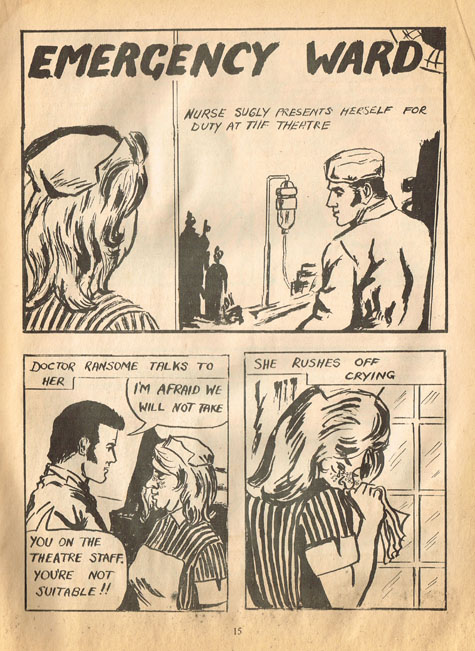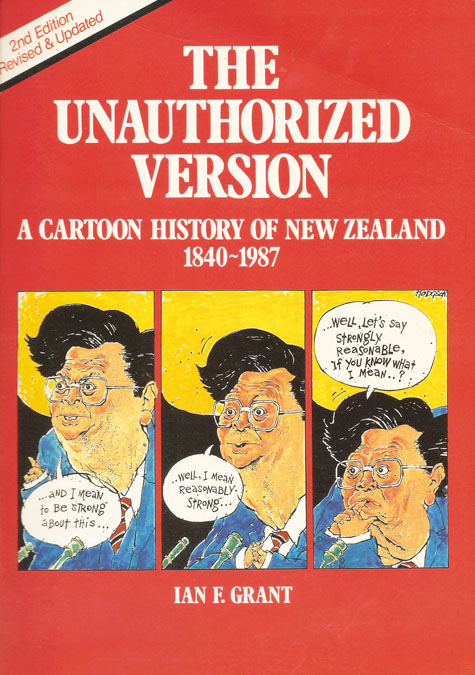An uncredited three page comic from 1970 Massey capping magazine Masskerade 70. Likely a satirical take on British television soap opera Emergency - Ward 10 (1954-1967) which featured in it's own comic series from Pearson, illustrated by Eric Dadswell. The back cover exemplifies the irreverent nature of capping magazines and their satirical take on government, religion, society and their own faculties.
Monday, September 10, 2012
Masskerade 70 - Emergency Ward
An uncredited three page comic from 1970 Massey capping magazine Masskerade 70. Likely a satirical take on British television soap opera Emergency - Ward 10 (1954-1967) which featured in it's own comic series from Pearson, illustrated by Eric Dadswell. The back cover exemplifies the irreverent nature of capping magazines and their satirical take on government, religion, society and their own faculties.
Saturday, September 8, 2012
Peter Foster at Melbourne Writers Festival 2012
Peter Foster talks with Bernard Caleo at the Skinny Arse comics launch about For The Term of His Natural Life at the 3 minute mark in this video courtesy of Dark Matter Fanzine.
Friday, September 7, 2012
Virgil Reilly War Illustrations
Wartime illustrations by Virgil Reilly for the No Man's Land Column in the Australian Woman's Weekly late 1939 - early 1940.
Thursday, September 6, 2012
Funtime Comics
Christchurch comics collective Funtime Comics have sent their latest anthology to the printers with contributors from across New Zealand and abroad. Issue #26 Zines, Zines, Music Hall Fruits sports a cover by Lee-Yan Marquez and comes almost two years after the previous issue. Artist's featured in this issue are: Ned Wenlock, Bob McMahon, Jason Franks Mike Athey, Daniel Brader, Ari Freeman, Debra Boyesk, Isaac Freeman, Marc Barnes, Tessa McLaughlin, Kurt Lewis, David Piper, Tim Danko and Steve Saville.
Check Funtime's Facebook for more details and information about regular drawing workshops in Christchurch hosted by Funtimes Editor Isaac Freeman.
Friday, August 31, 2012
Russell Clark
Russell Clarke self portrait from the posthumously released The drawings of Russell Clark.
Listen to a three minute clip from 1955 of Russell Clarke talking about his education and early inspiration in art here.
Tuesday, August 28, 2012
Wartime Advertising
Australasian magazines and papers were laden with advertising during wartime urging the populace to support the war effort through various means. The selection below are from World War Two are from the Australian Woman's Weekly. Though uncredited, it is possible regular weekly illustrators Virgil Reilly, Wep, Noel Cook, Amandus Julius Fischer, Arthur Sharland Boothroyd, and Wynn W Davies contributed to these campaigns.
Monday, August 27, 2012
Ian F. Grant Interview
Ian F. Grant has contributed immeasurably to the recording and preservation of New Zealand's cartooning history with the publication of his books The Unauthorized Version: A Cartoon History of New Zealand (1980, revised edition 1987) and Between The Lines: A Cartoon Century of New Zealand (2005) and foremostly the establishment of the New Zealand Cartoon Archive Trust initially run independently but now fully absorbed into the Alexander Turnbull Library . The collection includes the work of over 60 New Zealand and expatriate New Zealand cartoonists and over 25,000 cartoons. The New Zealand Cartoon Archive is comprised of publications, clippings, original artwork and material in digital form and has also published a series of books and monographs on New Zealand cartooning which are available here.
Ian F. Grant, Chairman of the New Zealand Cartoon Archive
Trust, Mr Peter Cartwright, H.E. The Hon. Dame Silvia
Cartwright, Governor General of New Zealand, and Rachel
Macfarlane, Cartoon Archive Trust Administrator, at the
hand-over to the Alexander Turnbull Library at the National
Library and the launch of Between the Lines on 27 October
2005.
Find more information on the New Zealand Cartoon Archive here.
Below is an excerpt of a longer interview with Grant currently in preparation for the 2012 PIkitia Press Book.
Did you have an interest in cartoons prior to being commissioned to write The Unauthorized Version: A Cartoon History of New Zealand ?
Yes,
in a variety of ways. I had my first practical brush with cartoonists
when I edited Victoria University of Wellington’s student newspaper, Salient, in 1960 and 1963 and the capping magazine, Cappicade in, I think 1961. I was one of the founding directors of National Business Review,
with editorial and marketing roles over 13 or so years from late 1970.
Prior to that I’d been a copywriter and creative director in Wellington
advertising agencies in the mid-1960s, tutored part-time at the School
of Design at Wellington Polytechnic and studied politics at Victoria
University. So by the time NBR started I had a reasonable background in
design and politics. I signed up Bob Brockie as NBR cartoonist in 1975
NBR’s market was senior management in the corporate sector and
government and I was aware of the famous and relevant UK example of UK
press baron Lord Beaverbrook who hired NZ cartoonist David Low, an
avowed socialist, to infuriate the readers of the Evening Standard
– and sell more newspapers. Bob was a socialist, politicised by the
Vietnam War, and his unflinching cartoons distressed our readers – and
sold more newspapers! So, one way or another, by the time I was asked to
write The Unauthorized Version I had a considerable, but very unspecialised, interest in political or editorial cartooning.
1961 Victoria University capping magazine Cappicade
What were the first cartoonists or cartoons that interested you in the medium and when was this?
I certainly wasn’t an early reader of comics; my parents did not approve of them. Instead I read magazines like Boy’s Own Paper and The Champion,
which a bit of a hybrid,but mainly text. I was interested in history
from a young age and I suppose the first cartoons I saw regularly were
in the history texts we had at secondary school – in the, as they were
then called, Form v, V1 and Upper Sixth. They were all English and often
illustrated with the work of leading Punch cartoonists. This
would have been in the mid-1950s. Being keen on sport, I used to enjoy
the front page cartoons in Wellington’s Sports Post in the late
1940s and early 1950s, with Neville Colvin and then Nevile Lodge the
cartoonists. I got to know them both decades later.
When you began initial research for The Unauthorized Version was there interest in the preservation of New Zealand cartoons by any professional institutions or private individuals?
No,
I don’t think it had occurred to anyone. I agreed to the project before
finding out how many editorial cartoons were in the Alexander Turnbull
Library and other research libraries in NZ – I did know the Mitchell in
Sydney had a very good collection. It turned out there were no
collections at all – just a few cartoons that had been deposited as
parts of collections of papers, etc. Of course, there were runs of the
magazines and newspapers that had carried cartoons but they were in
bound volumes in various places. Once the Cartoon Archive was launched a
few people emerged with clippings of the work of their favourite
cartoonists. I remember once receiving at home, without even a covering
letter, a large box of hundreds of Sid Scales’ cartoons carefully cut
out of the Otago Daily Times. New Zealanders were accustomed to
seeing cartoons in magazines and newspapers but very little had been
written about them. Pat Lawlor, a journalist who edited the NZ Artists’ Annual between 1926-32 and an NZ section in Aussie
knew all the cartoonists and wrote a little about them, but not always
very accurately. Even David Low, our most famous cartoonist, was little
more than a name.
Prior to establishing the New Zealand Cartoon Archive I've read that your house was used to store many boxes of cartoons. How did you manage to source these? And when did you realise there was an importance to ensuring the preservation of this material?
There were two aspects to researching The Unauthorized Version.
The most satisfying was the detective work, before aids like ‘Papers Past’ existed, digging out information about cartoonists who had had
very little, if anything, written about them previously. Less pleasant
was the grinding labour of going through many hundreds of bound volumes
in the bowels of the Parliamentary Library and at the Turnbull Library
then in the old Free Lance Building on the Terrace in Wellington. At the
Parliamentary Library, once I had found the cartoons I wanted, I’d go
up a spiral staircase to an area put aside for me where I held open the
heavy bound volumes with one hand while operating the microfilm camera
with the other. Not too much later most of these bound volumes were
dismantled for page-by-page microfilming and then disposed of. The
interest was primarily in keeping a record of the text on pages and it
transpired that a number of the cartoons were not able to be reproduced
satisfactorily.
I suppose, before I began working on the project, I realised that political cartoons had the ability to encapsulate and crystalise issues in a way that had a special clarity and insightfulness about it – and a close association with thousands of cartoons over several years simply reinforced this. Also, it soon became obvious that NZ had a long a particularly honourable cartooning tradition going back over a century and there were scores of unknown but very good cartoonists. And I also came to see that cartoonists had shown the depth of feeling about various issues – like the high levels of racial prejudice in the country – that had been glossed over, or missed entirely, in the general histories by people like Sinclair and Oliver. Cartoons were, and are, very good at showing prevailing gut feelings and reactions at any given time.
I came to see that it was important for the country to have a cartoon archive to honour all those cartoonists but also because of the importance of cartoons as historical sources that should take their place alongside the official records and documents that our historians have relied on for so long. Interestingly, this is a view that is increasingly accepted by historians in a number of countries.
I suppose, before I began working on the project, I realised that political cartoons had the ability to encapsulate and crystalise issues in a way that had a special clarity and insightfulness about it – and a close association with thousands of cartoons over several years simply reinforced this. Also, it soon became obvious that NZ had a long a particularly honourable cartooning tradition going back over a century and there were scores of unknown but very good cartoonists. And I also came to see that cartoonists had shown the depth of feeling about various issues – like the high levels of racial prejudice in the country – that had been glossed over, or missed entirely, in the general histories by people like Sinclair and Oliver. Cartoons were, and are, very good at showing prevailing gut feelings and reactions at any given time.
I came to see that it was important for the country to have a cartoon archive to honour all those cartoonists but also because of the importance of cartoons as historical sources that should take their place alongside the official records and documents that our historians have relied on for so long. Interestingly, this is a view that is increasingly accepted by historians in a number of countries.
Acknowledgement:Thanks to Chris Slane for putting me in touch with Ian F. Grant, Source: http://www.cartoons.org.nz/other_pages/story/story1.htm
Sunday, August 26, 2012
Comics in Australian Advertising in the 1930's
Advertising featuring comic strips from 1930's Australian Woman's Weekly. Artist's are uncredited but possibly include Wep, Noel Cook, Amandus Julius Fischer, Arthur Sharland Boothroyd, and Wynn W Davies who all contributed cartoons and illustrations to the magazine during this period.
Subscribe to:
Posts (Atom)















































